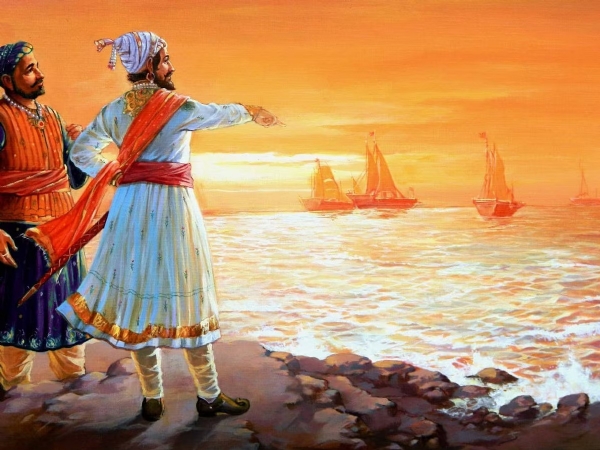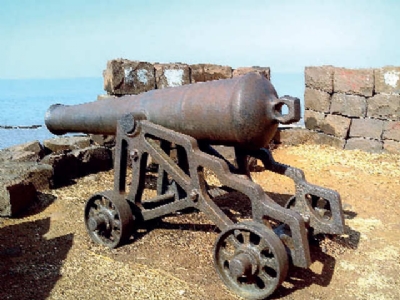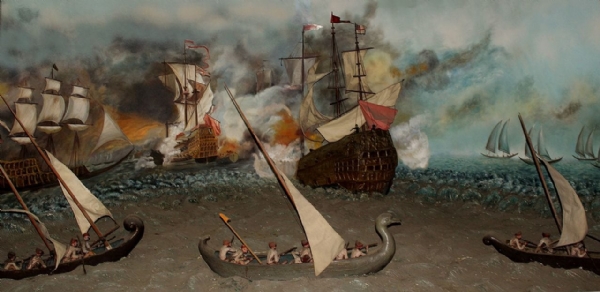Chhatrapati Shivaji Maharaj's Navy a versatile and multifaceted Fighting Force: Part 2
Shivaji Maharaj"s maritime strategy, Ganimi Kawa, showcased his exceptional leadership and military acumen.
Total Views |
Shivaji Maharaj laid the foundations for a strong naval force, his successors, the Peshwas, Kanhoji Angre further expanded and consolidated the Maratha Navy, making it a formidable maritime power in Western India during the 18th century.

Shivaji Maharaj's maritime strategy, Ganimi Kawa, showcased his exceptional leadership and military acumen. Through a combination of fortifications, shipbuilding, tactical innovations, and diplomatic maneuvers, he established the Maratha Navy as a formidable force in the Arabian Sea. His naval victories against the Portuguese, European powers, and the Siddis of Janjira bear testimony to his remarkable achievements. Shivaji Maharaj's maritime legacy remains an inspiration, underscoring the importance of strategic vision, innovation, and adaptability in achieving naval dominance.
The following aspects will covered in this article:-
1. Ships And Weapons Used By Shivaji Maharaj's Navy
2. Tasks Undertaken By Shivaji Maharaj's Navy
3. Tactics Employed by Shivaji Maharaj's Navy
4. Strengths of the Shivaji Maharaj's
5. Important Battles Fought by
6. Defeating The Siddi of Janjira
7. Shivaji Maharaj Navy a versatile and multifaceted entity
8. Training Imparted To Soldiers To Fight The European, Siddhi Navies Effectively
Shivaji Maharaj implemented various training methods to prepare his soldiers and sailors to effectively combat the European navies and the Siddhi Navy. The training focused on developing skills and tactics suited for naval warfare of that era.
Naval Combat Techniques: This included instruction in close-quarter combat, boarding enemy ships, and hand-to-hand combat skills. Soldiers were trained to use weapons such as swords, spears, and muskets effectively in the confined spaces of ships.
Ship Handling and Navigation: Training encompassed ship handling and navigation skills. Sailors were taught how to handle different types of vessels and smaller boats. They were trained in maneuvering ships, setting sails, navigating coastal waters, and understanding wind patterns and tides.
Gunnery Training: Soldiers and sailors were taught how to operate cannons effectively, including loading, aiming, and firing cannons accurately. Gunnery training also included knowledge of different types of ammunition and their uses.
Naval Warfare Tactics: This included tactics such as hit-and-run attacks, coastal raids, surprise assaults, and guerrilla warfare strategies. Soldiers were trained in the art of ambushing enemy ships, utilizing the element of surprise, and exploiting the coastal geography to gain an advantage.
Physical Fitness and Endurance: Soldiers and sailors were subjected to rigorous physical training. This included exercises to build strength, stamina, and endurance. Physical fitness was crucial for combat effectiveness, especially during boarding actions and long periods at sea.
The Mallakhamb, or vertical pole, erected on each ship served multiple purposes. It was primarily used for training and exercise of the soldiers on board. Soldiers would practice various physical exercises, such as climbing, balancing, and acrobatics, to improve their agility, strength, and combat skills.
Leadership and Discipline: Training programs emphasized obedience, teamwork, and the importance of following orders. Soldiers were trained to maintain discipline during battles and to exhibit strong leadership qualities when required.
Countering European Tactics: Shivaji Maharaj sought the assistance of European experts and adopted certain aspects of European naval warfare, such as the use of broadside cannon fire, in his training programs. This allowed his forces to effectively counter the tactics employed by European navies.
Shivaji Maharaj's training methods were dynamic and evolved over time. He regularly sought input from experienced sailors and experts and adapted his training programs based on the changing nature of warfare. This ensured that his forces were well-prepared to face the challenges posed by the European and Siddhi Navies.
Ships And Weapons Used By Shivaji Maharaj's Navy
The Gurab fighting ship was of 150-300 ton capacity and had two 9 to 12 pounder cannons in the front and 6 to 9 pounder cannons on the side.
The Galbat was a smaller ship with 2-4 pounder Canon guns,Ship was manned by 40-50 sailers and with speed of 6 km per hour.
Galbat: were large warships employed by the Maratha Navy. They were sturdy vessels with a robust structure and significant cargo-carrying capacity. Galbats were armed with cannons and equipped with multiple decks to accommodate a large crew.They were primarily used for naval warfare and played a crucial role in engaging enemy fleets and coastal defenses. These warships provided firepower, stability, and a platform for boarding actions.
Gallivat: were smaller ships used by the Maratha Navy. They were swift and maneuverable vessels, often equipped with sails and oars. Gallivats had a shallow draft, allowing them to navigate shallow coastal waters and enter narrow estuaries.They were versatile ships that performed various roles, including coastal patrol, reconnaissance, and escorting larger vessels. They were well-suited for hit-and-run tactics, coastal raids, and transporting soldiers for amphibious operations.
Merchant Ships Dhows
Dhows were traditional sailing vessels commonly used for trade and transportation in the Indian Ocean. They had a distinctive design with a triangular or lateen sail and a shallow draft, allowing them to navigate coastal waters effectively.
Shivaji Maharaj's navy made use of dhows for maritime trade and transportation along the coastal regions. These vessels played a role in facilitating commerce, ensuring the supply of goods, and maintaining connections with other regions.
The weapons used by Shivaji Maharaj's navy
Cannons: Cannons were an essential part of naval warfare during that time. They were mounted on the ships and used to fire heavy projectiles at enemy vessels or coastal fortifications.

Muskets and Firearms: Muskets and firearms were used by the naval soldiers for close-quarters combat. These weapons provided an advantage in boarding actions and during naval battles.
Swords and Daggers: Melee weapons like swords and daggers were used for hand-to-hand combat during boarding actions or when ships were engaged in close combat.
Bows and Arrows: Although the use of bows and arrows was less prevalent in naval warfare during Shivaji Maharaj's time, they were occasionally used for long-range engagements.
Tasks Undertaken By Shivaji Maharaj's Navy
Coastal Defense: One of the primary tasks of the Maratha Navy was to defend the Konkan coast and protect Maratha territories from coastal invasions by enemy forces. They were responsible for monitoring and safeguarding the coastline, coastal forts, and key ports against attacks from rival powers, such as the Portuguese, Siddis, and Mughals. Preventing European and Siddis, from harassing common people of Konkan was a very major task.
Challenging Portuguese Dominance: Shivaji Maharaj aimed to challenge their dominance and limit their control over the region. His Navy actively engaged in naval battles and skirmishes with the Portuguese fleet, disrupting their operations and weakening their hold on key ports and trade routes.
Raiding Enemy Ships and Ports: They would launch surprise attacks, capture enemy vessels, and seize valuable resources and supplies. These raids not only inflicted economic damage on the adversaries but also boosted the morale of the Maratha Navy.
Supporting Land Campaigns: His Navy played a vital role in supporting land campaigns by providing naval firepower and transport for troops and supplies. They would conduct amphibious operations, provide artillery support from the sea, and assist in the capture of coastal forts during land offensives.
Protecting Maritime Trade: His Navy was assigned the task of safeguarding Maratha merchant vessels and ensuring the safe passage of trade ships along the Konkan coast. This involved protecting them from pirate attacks and enemy privateers.
By effectively managing and deploying his naval forces, Shivaji Maharaj sought to secure his maritime territories, protect trade, challenge rival powers, and establish Maratha dominance in the region.
Tactics Employed by the Maratha Navy
Blockades: They employed blockades to impede enemy ports, effectively disrupting their trade and supply chains, thereby weakening their economy and military forces.
Raids: They conducted strategic raids on enemy shipping, seizing or destroying vessels and cargo, thus dealing significant blows to the enemy's economy and morale.
Transportation: They served as a vital transport entity, facilitating the movement of troops and supplies, particularly in support of the Maratha army during land campaigns.
Strengths of the Maratha Navy: The Maratha Navy showcased versatility, capable of fulfilling diverse roles and adapting to various situations.The navy possessed adequate resources and training, enhancing its operational effectiveness.The Maratha Navy benefited from the leadership of skilled and experienced commanders.Patriotism was the biggest quality which the Maratha soldiers had. They were fighting to create a Swarajya and were not mercenaries like the Mughals and Siddi.
Battles Fought Against Portugese, European And Siddis Of Jangira?
Shivaji Maharaj,s Navy engaged in several significant battles against the Portuguese, other European, and the Siddis. The Battle of Surat in 1664 demonstrated the Maratha Navy's well-coordinated use of both their army and naval forces. The Maratha Navy's victory over the Portuguese fleet in the Battle of Surat solidified the security of the Maratha coast, eliminating Portuguese interference.
Battle of Angediva (1661): The Maratha Navy, led by Captain Mainak Bhandari, confronted the Portuguese fleet near the island of Angediva. The Marathas successfully defeated the Portuguese forces and captured several Portuguese ships.
Battle of Bombay (1665): The Maratha Navy, commanded by Admiral Daulat Khan, engaged the Portuguese fleet near Bombay (now Mumbai). The Marathas achieved a decisive victory, capturing several Portuguese ships and inflicting heavy losses on the enemy.
Battle of Vindhyagiri (1670): In this battle, the Maratha Navy, fought against the combined forces of the Portuguese and Siddis of Jangira. Despite being outnumbered, the Marathas emerged victorious and seized control of the strategic island of Vindhyagiri.
Battle of Khanderi (1679): The Maratha Navy confronted the combined naval forces of the Portuguese and Siddis near the island of Khanderi. The Marathas successfully defended their positions and repelled the enemy, ensuring their dominance in the region.

Battle of Karwar (1683): The Maratha Navy, engaged the combined forces of the Portuguese and Siddis near Karwar. The Marathas emerged triumphant, inflicting heavy losses on the enemy and securing their control over the region.
These battles showcased the prowess of the Maratha Navy, to challenge and defeat their adversaries in the Arabian Sea.
How Shivaji Maharaj,s Navy Defeated Siddi
Siddi of Janjira, also known as Siddi Johar or Siddi Haidar, was an Abyssinian (Ethiopian) pirate who became the naval chief of the Siddi dynasty based in Janjira, a coastal fort. Siddi Johar was active during the 17th century, particularly during the reign of Shivaji Maharaj.
The Siddi navy, with its swift and maneuverable ships, conducted frequent raids on coastal towns and villages, capturing vessels, looting trade routes, and demanding protection money from local merchants. They were particularly notorious for their acts of piracy and coastal plundering.
The people of the Konkan region faced significant challenges due to the constant threat posed by Siddi Johar's naval forces. Comprehensive plan was made to defeat Siddi.
Blockade and Economic Siege: Shivaji Maharaj ordered a blockade of Janjira to cut off the fort from external supplies and resources. This economic siege put pressure on Siddi Johar and weakened his forces over time.
Fortification of Coastal Defense: Shivaji Maharaj fortified his own coastal defenses and established forts along the coastline. These forts acted as a defensive shield against Siddi Johar's forces and limited their expansion.
Coastal Raids: Shivaji Maharaj employed his naval forces to conduct frequent coastal raids on Janjira and its surrounding areas. These raids disrupted the enemy's activities, depleted their resources, and demoralized their troops.
Naval Encounters: They employed superior naval tactics, including ship-to-ship combat and boarding actions, to weaken the enemy and gain control of the maritime region.
Capture of Allied Ports: Shivaji Maharaj's navy captured and secured several ports and islands allied with Janjira. This deprived Siddi Johar of potential support and restricted his movements.
Diplomatic Alliances: Shivaji Maharaj formed alliances with other regional powers and European maritime forces to counter Siddi Johar's influence. These alliances provided additional naval support and hindered the Siddis' efforts.
Siege of Janjira: The fort was subjected to a relentless assault from land and sea, Shivaji Maharaj personally led numerous campaigns, demonstrating his strategic brilliance and naval expertise. One notable encounter was the Battle of Janjira in 1665, where Shivaji Maharaj besieged the formidable Janjira fort. Although the fort remained unconquered, the Marathas inflicted significant damage on the Siddi navy and disrupted their control over the region.
Through a combination of naval warfare, economic pressure, Shivaji Maharaj and his navy were able to defeat Siddi Johar and secure victory over the Siddi dynasty.
Shivaji Maharaj Navy a versatile and multifaceted entity
The naval prowess of Chhatrapati Shivaji Maharaj and his Maratha Navy was a force to be reckoned with. Their innovation, audacity, and strategic acumen in naval warfare were unparalleled."Shivaji's naval forces were highly organized and well-equipped, and they posed a significant challenge to European powers in the region." "The Maratha Navy, under the leadership of Shivaji Maharaj, emerged as a formidable naval power, successfully challenging the dominance of European naval forces in the Arabian Sea."Shivaji Maharaj's mastery of maritime warfare and his utilization of naval tactics were a testament to his brilliance as a military strategist.
--


